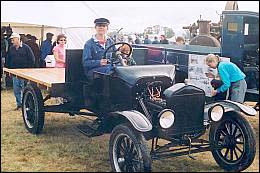Dorothy – 12/06/03
|
|
| Don Clarke on one of the engines originally owned by his father |
Vintage aircraft, traction engines and threshing mills took visitors back through the twentieth century to 1903 at the Richard Pearse Centennial Airshow and the W J Clarke Traction Engine Rally on 29-30 March. Steady rain resulted in disappointing attendances of around 3000 on the Saturday, but on the Sunday the weather cleared and well over 10,000 people attended the displays. The airshow kept the crowd entertained and the line up of fourteen traction engines driving threshing mills delighted a large crowd of enthusiastic operators and spectators, none more so than ninety three year old Don Clarke, the only surviving son of W J Clarke. A constant stream of visitors to the rally gathered around to talk to him and ask him about the heydays of the threshing mills.Don Clarke has vivid memories of the days when his father owned the engines and mills. He shared them for publication in NZine earlier this year.
W J Clarke bought his first traction engine and threshing mill in 1903 and at the peak of his business he had thirteen engines and mills, so the South Canterbury Traction Engine Club wanted to have thirteen engines and mills operating at the rally. When the day came they had fourteen and hoped to set a world record by having them all operating at once.
|
|
| Line up of engines awaiting the signal to start operating. |
Fourteen engines and mills operate at once and achieve a record They achieved their record despite the rain on the Saturday and repeated it on Sunday morning and again in the afternoon – every time without a hitch.
|
|
| Engines and mills in operation with sheaves being fed into the mills |
A hoot from the engine owned by John Kyle, W J Clarke’s grandson, gave the signal and teams of workers – mostly men but some women – began feeding sheaves to the mills. All the engines hooted in celebration at the finish.
To support the claim for a record to appear in the Guinness Book of Records video and photographic evidence had to be supplied and two written statements had to be sent as well. These were provided by the Mayor of Timaru, Wynne Raymond, and the well known English enthusiast for traction engines, Richard Parrott.
John Kyle and Esmay Pitt had prepared John’s engine for the rally.
|
|
| John Kyle and Esmay Pitt on John’s steam engine in the line up of engines and mills |
Esmay also assisted in the information tent and exhibited the Model T one ton truck which she and John had restored to its original condition – every nut and bolt. It had been used to carry coal to the engines.
|
|
| Esmay in the restored coal truck with her niece Crystal |
|
|
| The traction engine with its load – a magnet for visitors with cameras |
The power of the engines was demonstrated when one engine pulled three wagons fully loaded with bales of wool.
Airshow The engines filled the air with smoke, but above them on the Sunday the planes in the airshow flew in clear blue skies – among them gyrocopters, microlights, a mustang, a Hercules, a Tiger Moth, New Zealand’s only flying Catalina, agricultural aircraft, a Vampire fighter jet, Harvards, the Red Checkers flying team, the Royal New Zealand Air Force’s Iroquois helicopters and the Royal New Zealand Navy’s Seasprite helicopter.
Steve Taylor’s aerobatics, the Parachute team’s display, the Red Checkers Flying team and the demonstration of the work of agricultural aircraft were among the highlights.
|
|
| The Red Checkers planes sweep across the sky |
An excellent display of model aircraft also attracted enthusiastic spectators.
Pearse’s first flight Richard’s Pearse is believed by many people to be the first in the world to achieve powered take-off. This is thought to have taken place on 31 March 1903.
At the end of the weekend pageant crowds were fascinated by seeing the replica of Pearse’s aircraft made by South Canterbury people, with an engine made by Lex Westoby and his son Colin. In the pilot’s seat was Jack Melhopt. The propeller whirred into action – seemingly a good omen for an attempt to recreate Pearse’s flight the following day.
Planned activities for Monday 31 March On Monday 31 March, in the paddock at Waitohi that was the site of Pearse’s flight, pilot Jack Melhopt hoped to become airborne in a replica plane made by Geoff Rodliffe in conjunction with the Museum of Transport and Technology (Motat) in Auckland.
The people of Waitohi organised the Procession of the Decades to honour the date and the attempt to recreate Pearse’s flight. They planned floats or parades and vehicles from each decade and fly-pasts by aircraft from each era starting with today’s transport and working back to 1903. About 1000 schoolchildren were also involved.
The good weather that favoured the pageant on the Sunday did not last. On Monday rain and quite strong winds made the attempt to become airborne too dangerous. Those in the procession finished the day wet and cold.
But the South Canterbury people ended the celebrations delighted at the public response and the media coverage given to Pearse’s achievement, to W J Clarke’s threshing mills and to the history of the area kept alive by so many enthusiasts.
A replica plane can be seen at the Richard Pearse Memorial.










